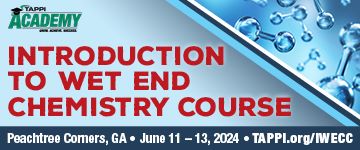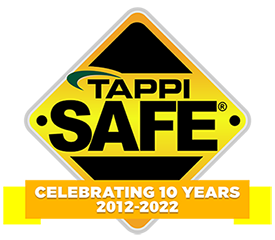 Search
Search
Use the search bar or filters below to find any TAPPI product or publication.
Filters
Publications
Level of Knowledge
Collections
Journal articles

Magazine articles

Root cause analysis of cationic polymer additive efficiency decline in virgin and recycle containerboard mills, TAPPI Journal January 2020
ABSTRACT: It is well known that retention, drainage and strength polymers struggle to perform (if at all) in virgin containerboard mills. In-depth studies have been undertaken in this area for more than seven years, investigating the issue from all directions. A key finding of this work is that soluble lignin is detrimental to chemical efficiency. A strong correlation exists between decreased chemical efficiency and high soluble lignin. Both recycled systems and virgin systems have been studied, and this correlation holds true regardless of furnish. The primary area of concern is virgin container-board, because these mills tend to have the highest lignin levels. Some highly closed recycled mills can also build elevated lignin levels that can negatively affect chemical efficiency.
Journal articles

Magazine articles

Flow rheology of light foams generated from aqueous solutions of polyvinyl alcohol, TAPPI Journal January 2023
ABSTRACT: Recent studies have shown that foam-assisted application of additives into a wet web has advantages over the conventional way of adding the chemicals into the pulp suspension before forming, e.g., increased mechanical retention as well as high dosage giving increased wet strength without impairing the sheet uniformity. To engineer processes utilizing this new technology, the complex flow behavior of applied foams must be quantified. At the minimum, the foam viscosity and the slip velocity at the solid surfaces need to be known to build practical models that can be used in analyzing and upscaling unit processes of the foam-assisted application.In this study, the rheological behavior was quantified for foams having polyvinyl alcohol (PVOH), a widely used strength additive chemical, as the surfactant. The foam density was varied between 100 g/L and 300 g/L, and the concentration of the PVOH solution was varied between 0.5% and 6.0% (w/w). The foams were generated with a commercial foam generator, and the rheological properties of the foams were measured by using a horizontal pipe bank. At the outlet from the generator, the volumetric flow rate, the absolute pressure, and the bubble size distribution of the foam were measured. In the measurement pipe section, the viscous pressure gradient and the slip velocity were measured, after which the foam was discharged to ambient air pressure. The viscosity and the dynamic surface tension of the PVOH solutions were quantified with commercial laboratory devices. In the viscosity analysis, the apparent shear rate was calculated from the volumetric flow rate, and the resulting apparent viscosity was translated to real material viscosity data by applying the Weissenberg-Rabinowitsch correction. The results indicated that PVOH foams can be described with high accuracy as shear-thinning power-law fluids where the detailed behavior depends on the foam density and the PVOH concentration. Slip flow, as usual, increased with increasing wall shear stress, but it was also dependent on the PVOH concentration, the air content, and the bubble size. For both the foam viscosity and the slip flow, a correlation was found that described the quantitative behavior of all the studied foams with good accuracy.
Journal articles

Magazine articles

Investigation of the Cellulose-Water Relationship by the Pressure Plate Method, TAPPI Journal July 2022
ABSTRACT: The swelling and water retention properties of pulp fibers are of basic importance in papermaking.
Journal articles

Magazine articles

Rewet in wet pressing of paper, TAPPI JOURNAL September 2018
Rewet in wet pressing of paper, TAPPI JOURNAL September 2018
Journal articles

Magazine articles

Comparative study of guar gum and its cationic derivatives as pre-flocculating polymers for PCC fillers in papermaking applications, TAPPI Journal April 2022
ABSTRACT: In this work, gums from guar seeds were evaluated as a potential precipitated calcium carbonate (PCC) filler pre-flocculant to induce functional filler in papermaking applications. In recent years, guar has been conidered one of the promising wet-end additives due to its abundance, rich source of hemicellulose content, and bio-degradability. However, application of guar gum in filler pretreatment methods for producing high ash paper has scarcely been reported. In this paper, the flocculating ability of three types of guar gum was established with charge analysis and turbidity (NTU) of the system at 1% and 5% for each gum: native gum (NG) having a degree of substitution (DS) of 0, and cationic gums having a DS value of 0.07 (CL) and 0.15 (CH). It was interesting to observe that even at a 5% dose of G, the charge density of PCC did not deviate much from the initial values. The system carried a weak negativeharge, resulting in an unstable colloidal suspension that led to PCC-PCC particle bridging. On the other hand, the operative mechanism of CL and CH during adsorption and PCC flocculation was predicted to be charge neutralization and electrostatic-patch formation, accompanied by particle bridging. Note that CL, with a maximum 47.5% eduction in residual turbidity of PCC at a 1% dose, was much more efficient in doing so than the other two gums; NG had a 40% maximum reduction in residual turbidity at a 5% dose and CH had a maximum 30% reduction at a 1% ose. Later on, floc formation and structure were correlated with optical and field emission scanning electron microscopy (FE-SEM) images. In the next set of trials, paper properties were determined by varying the different gum dosages from 0.2% to 5% at a constant dose of 20% filler. It is also noteworthy to mention that with 1% CL (low DS) dose, PCC retention increased by 39%, which also enhanced the tensile, tear, burst, and opacity properties by 11%, 19%, 5%, and 4.4%, respectively, without significantly affecting the bulk properties. Further, wide-angle X-ray diffraction (XRD) analysis nd Fourier transform infrared (FTIR) analysis revealed that pre-flocculating PCC with a 1% gum dose did not induce any change in crystalline transformation. Based on observation, it was found that cationic gums with low DS values re a better choice for maximizing the strength of paper while maintaining bulk and high opacity when pre-flocculaion is adopted to increase the filler retention in paper.
Journal articles

Magazine articles

Application of spruce wood flour as a cellulosic-based wood additive for recycled paper applications— A pilot paper machine study, TAPPI Journal October 2021
ABSTRACT: This study gives a first insight into the use of wood flour as a plant-based and cellulosic-based alter-native additive for newsprint and paperboard production using 100% recycled fibers as a raw material. The study compares four varieties of a spruce wood flour product serving as cellulosic-based additives at addition rates of 2%, 4%, and 6% during operation of a 12-in. laboratory pilot paper machine. Strength properties of the produced news-print and linerboard products were analyzed. Results suggested that spruce wood flour as a cellulosic-based additive represents a promising approach for improving physical properties of paper and linerboard products made from 100% recycled fiber content. This study shows that wood flour pretreated with a plant-based polysaccharide and untreated spruce wood flour product with a particle size range of 20 μm to 40 μm and 40 μm to 70 μm can increase the bulk and tensile properties in newsprint and linerboard applications.
Journal articles

Magazine articles

Evaluation of rice straw for purification of lovastatin, TAPPI Journal November 2021
ABSTRACT: Cholesterol synthesis in the human body can be catalyzed by the coenzyme HMG-CoA reductase, and lovastatin, a key enzyme inhibitor, can reduce hypercholesterolemia. Lovastatin can be obtained as a secondary metabolite of Aspergillus terreus ATCC 20542. In this study, rice straw of lignocellulose was used in aeration and agitation bath fermentation in a 1-L flask, and a maximal crude extraction rate of 473 mg/L lovastatin was obtained. The crude extract was treated with silica gel (230–400 mesh) column chromatography. Ethyl acetate/ethanol (95%) was used as the mobile phase, and isolation was performed through elution with various ethyl acetate/ethanol ratios. The highest production rate of 153 mg/L was achieved with ethyl acetate/ethanol in a ratio of 8:2. The lovastatin gained from the crude extract was added to 12 fractions treated with 0.001 N alkali, and acetone was then added. After 24 h of recrystallization at 4°C, the extract underwent high-performance liquid chromatography. The purity had increased from 25% to 84.6%, and the recovery rate was 65.2%.
Journal articles

Magazine articles

Editor's Note: An Ideal Raw Material for Pulp and Paper, TAP
Editor's Note: An Ideal Raw Material for Pulp and Paper, TAPPI JOURNAL March 2010
Journal articles

Magazine articles

Effect of pressure and time on water absorption of coated paperboard based on a modified Cobb test method, TAPPI Journal April 2024
ABSTRACT: This manuscript presents the study of water absorption by paperboard subjected to water at high hydrostatic pressure based on a modified Cobb tester. The new tester is based on TAPPI Standard Test Method T 441; however, the water column can reach up to 550 mm. The evaluation consisted of measurements of water absorption for coated and uncoated paperboard at different exposure times from 5 s to 45 s and water column heights from 10 mm to 500 mm (corresponding to hydrostatic pressures 98 Pa and 4.9 kPa, respectively). The coatings were formulated as a combination of styrene acrylate (SA; two binder levels) and two types of ground calcium carbonates (differing particle sizes) to form the two pre-coating structures: open and closed. The coating weight was 6 g/m2 applied on 210 g/m2 solid bleached board (SBB). In addition, 210 g/m2 uncoated boards were studied. Characterization of the coatings was performed with scanning electron microscopy (SEM), mercury intrusion, and roughness. It was found that the new device properly mimics the conditions of the current Cobb tester. The characterization of the coating also confirmed the presence of more open/larger pores of open coatings, confirming the desired coating structure. The absorption of boards was mainly driven by exposure pressure by comparing with exposure time. This was already evident after shorter periods of exposure time at 5 s and also 15 s exposure time. Paperboards with open coatings showed slightly higher absorption than other boards.
Journal articles

Magazine articles

Editorial: TAPPI Journal Best Research Paper for 2023 focuses on black liquor concentration using graphene oxide membranes, TAPPI Journal February 2024
ABSTRACT: TAPPI and the TAPPI Journal (TJ) Editorial Board would like congratulate the authors of the 2023 TAPPI Journal Best Research Paper Award and Honghi Tran Prize: Sam Rae, Ella V. Richards, Max Kleiman-Lynch, Brent D. Keller, and Brandon I. Macdonald. Their paper, “Pilot scale black liquor concentration using pressure driven membrane separation,” appeared on p. 223 of the April 2023 issue. This kraft recovery cycle research was recognized by the TAPPI Journal Editorial Board for its innovation, creativity, scientific merit, and clear expression of ideas.






